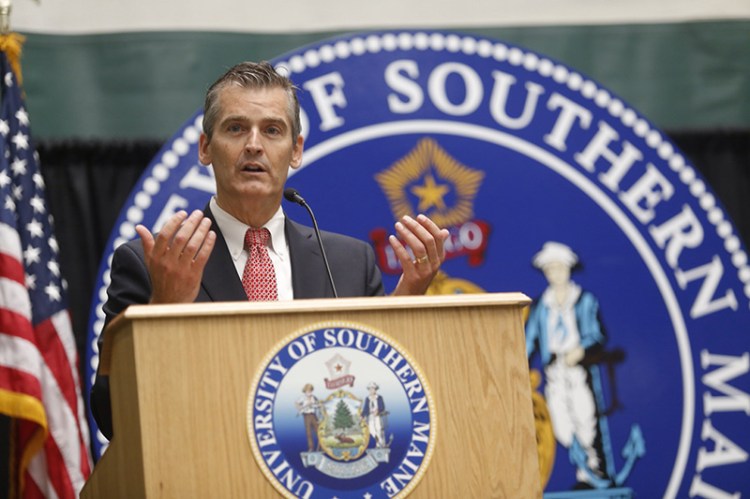University of Southern Maine students protesting racism on campus met with President Glenn Cummings, demanding changes to training, class requirements and hiring.
“They laid out a plan of what they would like to see happen and that (list) correlated well with what I would like to see happen, so I said we have to work together,” Cummings said Wednesday.
Five students presented a 10-point “list of demands” during an “extremely productive” one-hour meeting at his office on Monday, he said.
The students, some affiliated with the Portland Racial Justice Congress and the Black Lives Matter movement, have organized two protests in recent weeks to decry racism and pledge their support to other university students who are protesting nationwide.
Among the demands are increasing diversity in faculty and staff, requiring additional training for employees and students, better tracking and transparency around reported racial incidents on campus, ensuring the existing diversity class requirement for graduation includes discussions of race and oppression, retaining students of color, and including people of color on the campus’s new Diversity Council.
The demands presented by students to USM President Glenn Cummings:
Posted by Students for #USMfuture on Tuesday, December 22, 2015
“I think the students’ concerns are very sincere and they are authentically very pragmatic things that need to be done to enhance our openness and support for a diverse culture,” Cummings said. “Their leadership is a gift to the university right now.”
The students’ demands coincide with nationwide university protests that peaked in November when the president of University of Missouri resigned after a student went on a hunger strike and black players on the school’s football team refused to practice because protesters thought the administration was ignoring the concerns of black students. Other protests have rallied around similar concerns of racism on campus, but there has been some backlash against charges of racism that were sparked, in one case, by a dispute over the Yale administration’s advice about Halloween costumes and, in another, over the cultural authenticity of “ethnic” food in the school cafeteria at Oberlin College.
The situation at USM is different, Cummings said, pointing to mutual goals shared by the students and the administration.
“When I look at what they’re asking for – like to hire more people who look like us – I agree with them. That’s a fair ask,” Cummings said. “I think they have listed out a set of demands that are both reasonable and would make our university better.”
The school is on winter break and attempts to reach students at the meeting through email and social media were unsuccessful Wednesday.
However, the students already had outlined several of the demands in a protest earlier this month that drew abut 100 people to the Woodbury Campus Center. Iris SanGiovanni, one of the students who met with Cummings, said then that the demands were “a call to action for equality and justice.”
Cummings said several of the students’ demands were either already underway or in the process of being created. He said at the Woodbury protest that he would meet with students and others in January and create an action plan for USM by mid-February.
USM started new bias training this fall for all members of the university’s search and hiring committees, and created a Diversity Council open to anyone who wants to join. Tracking reported incidents of racism is already done, and Cummings said the students plan to meet with other members of the administration to discuss that process in more detail.
“Any time any student feels unsafe on this campus, it is my responsibility and the campus’s responsibility to take that very seriously. We are in agreement that it’s important,” he said.
That said, “we can’t fulfill every request,” Cummings said. He noted that hiring decisions fall under union rules, and a demand that the university “revise speech code … (and) stop using coded language ‘civility, diversity, etc. …’ ” was more of a discussion point. Cummings said he thought those terms were valid, but agreed that they should not be used as euphemisms for more direct language about racism.
Black students make up slightly less than 3 percent of USM’s 8,226 undergraduate students, while 73 percent identify as white, according to campus data. As of fall 2014, minorities made up 5 percent of the campus’s 622 instructional faculty, which includes adjuncts.
“We did lose some faculty of color in the retrenchments,” said Acting Provost Jeannine Uzzi, who was herself laid off in the retrenchments and recently returned to campus. “When I was hired, Glenn (Cummings) and I defined a number of priorities and increasing the diversity of faculty and staff was among those things.”
Uzzi said they are waiting for a conclusion to arbitration talks that may undo some of last year’s retrenchments, but the plan is to hire up to 15 faculty this year. She also led the effort to institute the new training for hiring committee members.
“I saw this as a real chance to potentially increase the diversity of our faculty through new hires, and to ask faculty to get new training in diversity and inclusivity,” Uzzi said. “I feel like (it’s) one of my major accomplishments.”
Regarding the other demands, Uzzi said she saw several opportunities to work with the students, particularly around academic issues.
Students would be welcome, she said, on curriculum committees to recommend changes to the diversity requirement, noting that the faculty and not the administration controls the curriculum.
“USM endeavors to have many more students of color, we want them in our community,” she said. “The students are trying to make USM better than it is. I admire them for expressing their values.”
Note: On Jan. 28, the Portland Press Herald published a letter from USM President Glenn Cummings saying USM did not lay off any faculty of color during budget-related staff cuts in the 2014-15 academic year.
Send questions/comments to the editors.




Comments are no longer available on this story